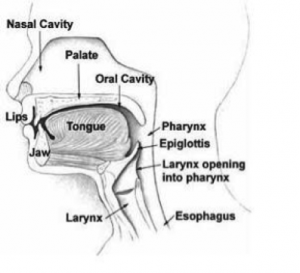Feeding and the Swallow Mechanism Biology Diagrams Deglutition or swallowing is an innate function. Swallowing sounds like a simple physiological human function, but it is a complex, multifaceted process involving a variety of muscles and nerves. It is the starting point for the peristaltic transport of food to the stomach. Deglutition in humans can be of three distinct phases: oral phase, pharyngeal phase, and esophageal phase, of which the

ADVERTISEMENTS: Deglutition or swallowing is probably a reflex phenomenon. Higher centres facilitate this reflex. Once aroused, the swallowing centre in the medulla evokes the complete act of swallowing by discharge through six nuclei and the motor neurones. This reflex act occurs in three stages: (1) First or oral, ADVERTISEMENTS: (2) Second or pharyngeal, and (3) […] The Pharyngeal Phase . As the food bolus reaches the pharynx, special sensory nerves activate the involuntary phase of swallowing. The swallowing reflex, which is mediated by the swallowing center in the medulla (the lower part of the brain stem), causes the food to be further pushed back into the pharynx and the esophagus (food pipe) by rhythmic and involuntary contractions of several muscles The process of swallowing, also known as deglutition, involves the movement of substances from the mouth (oral cavity) to the stomach via the pharynx and esophagus. Swallowing is an essential and complex behavior learned very early in development. This pathway shares anatomy with the airway; thus, in addition to directing food into the digestive tract, the swallowing mechanism serves as a

Physiology, Swallowing Biology Diagrams
With a normal swallow, food and liquids move from the mouth into the esophagus directed by a precise sequence of coordinated muscle movements. In order to adequately describe the biomechanics and bolus movement during swallow, the 4 stage model was developed: Oral Prepatory Stage, Oral Transit Stage, Pharyngeal Stage, and Esophageal Stage. Swallowing, also called deglutition or inglutition [1] in scientific contexts, is the process in the body of a human that allows for a substance to pass from the mouth, to the pharynx, and into the esophagus, while shutting the epiglottis.Swallowing is an important part of eating and drinking.If the process fails and the material (such as food, drink, or medicine) goes through the trachea

Normal swallowing requires a coordinated effort of over thirty muscles, the central nervous system, and five cranial nerves. Other key anatomical structures involved in this process are the nose, nasal cavity, oral cavity, and pharynx. This article explores the relevant anatomy and physiology of normal swallowing.

Anatomy and Physiology of Feeding and Swallowing Biology Diagrams
The oral phase of swallowing is the first stage of deglutition, and it is a voluntary process. It is also commonly known as the buccal phase.It involves the contraction of the tongue to push the bolus up against the soft palate and then posteriorly into the oropharynx by both the tongue and the soft palate.. The pressure that the food bolus places on the posterior oropharynx activates the
